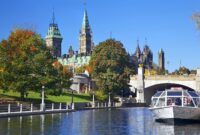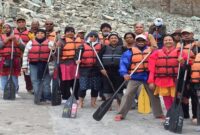Trips for senior adults offer a unique blend of relaxation, adventure, and cultural enrichment. This guide explores diverse travel options tailored to the needs and preferences of older adults, addressing everything from planning and budgeting to health considerations and accessibility. Whether you envision a leisurely cruise, an active hiking tour, or a culturally immersive experience, we’ll help you craft an unforgettable journey that prioritizes comfort, safety, and enjoyment.
We delve into various trip categories, comparing different transportation modes, and providing practical tips for budgeting and selecting senior-friendly accommodations. We also highlight the importance of considering health and safety aspects, ensuring a stress-free and rewarding travel experience. Discover how to plan your ideal getaway, enriching your life with new experiences and lasting memories.
Types of Trips for Senior Adults
Choosing the right travel experience is crucial for senior adults, ensuring both enjoyment and safety. The ideal trip will depend heavily on individual mobility, interests, and health considerations. Careful planning, considering accessibility and potential health concerns, will contribute significantly to a positive and memorable experience.
Trip Categories Based on Activity Level
Senior travel can be categorized based on the level of physical activity involved. This allows for a more tailored selection, matching the trip to the individual’s capabilities and preferences. Matching the activity level to the individual’s physical capacity is key to a successful and enjoyable trip.
| Trip Type | Location Examples | Activities | Suitability |
|---|---|---|---|
| Active Adventure | Hiking trails in the Rockies (e.g., sections of the Appalachian Trail with accessible options), active cycling tours in Tuscany, Italy | Hiking (shorter, less strenuous trails), guided cycling excursions, kayaking (calm waters), light rock climbing (with appropriate support), nature walks | Good physical fitness required. May not be suitable for those with mobility issues or heart conditions without careful medical clearance and appropriate support. |
| Moderate Activity | Coastal towns in Maine, National Parks with accessible trails (e.g., Acadia National Park, with options for car access to many viewpoints), walking tours of European capitals (Rome, Paris) | Moderate walking, sightseeing tours (with breaks), boat trips, visiting museums and historical sites, gentle bike rides on flat terrain | Reasonable level of fitness needed. Trips should include regular rest stops and opportunities to sit. Individuals with some mobility limitations may participate with appropriate accommodations. |
| Relaxed and Rejuvenating | Luxury cruises, spa resorts in Arizona or California, all-inclusive resorts in the Caribbean | Relaxation, spa treatments, leisurely meals, swimming (in accessible pools), gentle water aerobics, scenic drives, socializing | Suitable for individuals with limited mobility. Focus is on comfort and relaxation. Accessibility features in accommodation and transportation are crucial. |
Accessibility and Health Considerations for Senior Travel
Accessibility is paramount when planning trips for senior adults. This includes considering factors such as wheelchair accessibility in transportation and accommodation, the availability of ramps and elevators, and the presence of grab bars in bathrooms. Pre-existing health conditions must also be considered. For example, individuals with heart conditions might need to avoid strenuous activities, while those with arthritis might benefit from trips with minimal walking. Carrying necessary medications and having readily available access to medical care are also crucial considerations. It’s advisable to consult with a physician before undertaking any trip, especially if there are pre-existing health concerns. Travel insurance is highly recommended.
Planning & Budgeting for Senior Travel
Planning a trip as a senior citizen requires careful consideration of various factors to ensure a safe, enjoyable, and affordable experience. This involves meticulous research, realistic budgeting, and attention to detail throughout the entire process, from initial concept to post-trip reflection. Failing to plan adequately can lead to unforeseen expenses, physical strain, and overall dissatisfaction.
Steps Involved in Planning a Senior-Friendly Trip
Thorough planning is crucial for a successful senior travel experience. This begins with identifying the destination and desired activities, considering accessibility and physical limitations. Subsequent steps involve researching accommodations, transportation, and potential excursions, ensuring they cater to the needs and preferences of senior travelers. Finally, booking accommodations and transportation in advance is recommended to secure the best deals and avoid last-minute surprises.
- Destination Selection: Consider factors like climate, accessibility (e.g., flat terrain, availability of ramps and elevators), and proximity to medical facilities. Popular destinations for seniors often include locations with mild weather, rich cultural experiences, and a slower pace of life.
- Accommodation Research: Look for hotels or resorts that offer senior-friendly amenities such as accessible rooms, grab bars in bathrooms, and assistance with luggage. Consider proximity to attractions and transportation options.
- Transportation Planning: Choose transportation methods that minimize physical exertion. This might involve pre-booked airport transfers, taxis, or using public transportation with accessible routes. For longer distances, consider train travel as a more comfortable alternative to flying.
- Activity Selection: Plan activities that are physically manageable and enjoyable. Consider pacing activities throughout the day to avoid overexertion. Opt for guided tours or organized excursions to minimize logistical challenges.
- Booking and Confirmation: Confirm all bookings well in advance, including flights, accommodations, and tours. Keep copies of all confirmations and relevant documents readily accessible.
Budgeting Tips for Senior Travelers
Budgeting for senior travel requires a comprehensive approach that accounts for various expenses beyond the usual travel costs. It’s essential to factor in potential medical emergencies, travel insurance, and the possibility of unexpected expenses. Taking advantage of senior discounts and utilizing budget-friendly travel strategies can significantly reduce overall costs.
- Travel Insurance: Essential for covering medical emergencies, trip cancellations, and lost luggage. Compare policies from different providers to find the best coverage at a reasonable price.
- Medical Expenses: Factor in potential medical costs, including doctor visits, prescription medications, and emergency care. Consider travel insurance that includes medical evacuation coverage.
- Senior Discounts: Many airlines, hotels, and attractions offer discounts for senior citizens. Inquire about senior rates when booking flights, accommodations, and tours.
- Accommodation Costs: Consider staying in budget-friendly accommodations such as guesthouses, bed and breakfasts, or vacation rentals. Compare prices across different platforms to find the best deals.
- Transportation Costs: Explore cost-effective transportation options such as public transport or ride-sharing services. Consider purchasing multi-day passes for public transportation if applicable.
Sample 7-Day Itinerary: A Relaxing Coastal Getaway
This itinerary focuses on a relaxing coastal getaway, prioritizing comfort and accessibility. The estimated costs are approximate and may vary depending on the specific location and choices made.
- Day 1: Arrival and check-in at a beachfront hotel with accessible rooms (e.g., a hotel with ramps and elevators). Estimated cost: $150 (accommodation).
- Day 2: Gentle stroll along the beach, enjoying the ocean views. Lunch at a seaside café. Estimated cost: $50 (lunch and incidentals).
- Day 3: Guided tour of a local historical site with accessible pathways. Afternoon relaxation by the pool. Estimated cost: $75 (tour and entrance fees).
- Day 4: Scenic boat trip with accessible boarding. Dinner at a restaurant with ocean views. Estimated cost: $100 (boat trip and dinner).
- Day 5: Visit a local market, browsing local crafts and produce. Afternoon spent reading a book in a quiet park. Estimated cost: $30 (souvenirs and snacks).
- Day 6: Relaxing spa treatment at the hotel. Enjoy a light dinner at the hotel restaurant. Estimated cost: $120 (spa treatment and dinner).
- Day 7: Check-out and departure. Estimated cost: $50 (transportation to airport).
Transportation Options for Seniors
Choosing the right mode of transportation is crucial for a successful and enjoyable senior travel experience. Factors such as comfort, accessibility, cost, and travel time significantly impact the overall journey. This section explores various transportation options, highlighting their advantages and disadvantages to aid in informed decision-making.
Air Travel for Seniors
Air travel offers speed and efficiency, making it ideal for long-distance trips. However, navigating airports and managing luggage can present challenges for seniors. Potential difficulties include navigating long distances between gates, dealing with crowded spaces, and lifting heavy baggage. Solutions include booking assistance with airlines for wheelchair assistance or pre-boarding privileges, selecting direct flights to minimize transfers, and using lightweight, rolling luggage. Consider booking flights with airlines known for their senior-friendly services.
Cruises for Seniors
Cruises provide an all-inclusive travel experience with built-in entertainment, dining, and transportation. This eliminates the need for frequent packing and unpacking and offers a relaxed pace of travel. However, some cruise ships may lack sufficient accessibility features for those with mobility issues. Potential challenges include navigating stairs, accessing smaller lifeboats, and dealing with potential sea sickness. Solutions include selecting ships known for their accessibility features, requesting a cabin closer to amenities, and utilizing motion sickness remedies if needed. Researching cruise lines with dedicated staff for senior assistance is also recommended.
Train Journeys for Seniors
Train travel offers a comfortable and scenic alternative to air travel, with more legroom and less turbulence. The slower pace allows for leisurely sightseeing. However, train travel can be slower than air travel, and accessibility features vary across different train lines and countries. Challenges include navigating train stations, accessing restrooms, and dealing with potential delays. Solutions include booking accessible seating in advance, using assistance services offered by train companies, and planning for potential delays by allowing extra travel time.
Road Trips for Seniors
Road trips offer flexibility and control over the itinerary, allowing for stops at points of interest along the way. However, long driving hours can be tiring, and navigating unfamiliar roads can be challenging. Potential challenges include fatigue, managing long driving distances, and navigating unfamiliar routes. Solutions include breaking up long drives into shorter segments, utilizing GPS navigation systems, and taking frequent rest stops. Consider traveling with a companion who can share driving responsibilities.
Comparative Table of Transportation Options
| Transportation Method | Cost | Comfort | Accessibility | Travel Time |
|---|---|---|---|---|
| Air Travel | High | Moderate (can be cramped) | Moderate (varies by airline and aircraft) | Fast |
| Cruises | Moderate to High | High | Moderate (varies by ship) | Variable, often slower |
| Train Journeys | Moderate | High | Moderate (varies by train line) | Moderate to Slow |
| Road Trips | Low to Moderate | Moderate (depends on vehicle and driving conditions) | High (if using a private vehicle) | Slowest |
Accommodation & Accessibility
Choosing the right accommodation is paramount for a smooth and enjoyable senior travel experience. The focus should be on selecting places that prioritize comfort, safety, and ease of access, minimizing potential stress and maximizing the opportunity for relaxation and exploration. Factors such as accessibility features, proximity to medical services, and the availability of helpful amenities significantly impact the overall quality of the trip.
Selecting senior-friendly accommodations goes beyond simply finding a comfortable bed. It involves considering the specific needs and limitations that may arise with age. Ensuring ease of movement, access to medical assistance if needed, and convenient access to essential amenities significantly contributes to a more relaxed and enjoyable travel experience. Prioritizing these aspects allows seniors to focus on enjoying their trip rather than navigating potential challenges.
Senior-Friendly Accommodation Amenities and Services
Many hotels and resorts now cater specifically to the needs of senior travelers, offering a range of specialized amenities and services. These accommodations often feature larger rooms with easy access, grab bars in bathrooms, roll-in showers, and adjustable beds. Some may even offer on-site medical assistance, transportation services, and organized activities tailored to the physical capabilities of older adults. Examples include dedicated senior living communities that offer travel packages, hotels with designated accessible floors and rooms, and resorts featuring adapted activities and facilities. These specialized accommodations ensure a comfortable and safe environment, minimizing potential obstacles and enhancing the overall travel experience. For instance, a hypothetical “Sunrise Senior Suites” might feature spacious rooms with walk-in showers, grab bars, and emergency call buttons, along with daily housekeeping and concierge services. Alternatively, a “Tranquil Tides Resort” could offer modified excursions and activities, such as gentle boat tours or adapted yoga sessions.
Questions to Ask When Booking Senior-Friendly Accommodations
Before confirming a booking, it’s crucial to verify that the accommodation meets the specific needs of the senior traveler. Asking clarifying questions ensures a comfortable and safe stay.
- What accessibility features are available in the rooms and common areas (e.g., ramps, elevators, grab bars, roll-in showers)?
- Is there on-site medical assistance or a nearby medical facility easily accessible?
- What transportation options are available to and from the accommodation, and are they accessible to seniors with mobility limitations?
- Are there any organized activities or excursions suitable for seniors with varying levels of mobility and fitness?
- What emergency procedures are in place, and how easily can assistance be obtained in case of an accident or medical emergency?
- Are there any specific services tailored to seniors, such as assistance with luggage or meal preparation?
- What is the proximity to essential amenities such as pharmacies, grocery stores, and restaurants?
Health & Safety Considerations
Safe and healthy travel is paramount for senior adults, requiring proactive planning and awareness. This section outlines essential precautions to ensure a worry-free and enjoyable trip, addressing potential health risks and providing resources for medical assistance.
Prioritizing health and safety during travel is crucial for senior adults. Careful planning minimizes risks and ensures a smoother, more enjoyable experience. This includes considering pre-existing health conditions, necessary medications, and emergency preparedness.
Travel Insurance and Necessary Medications
Comprehensive travel insurance is highly recommended for senior travelers. Policies should cover medical emergencies, evacuations, and trip cancellations or interruptions. It’s essential to choose a policy that adequately addresses the specific health needs and potential risks of the individual. Before departure, ensure you have an adequate supply of all prescribed medications, including copies of prescriptions. Pack medications in their original containers and carry them in your carry-on luggage to avoid loss or damage. Consider consulting your doctor about obtaining extra medication in case of delays. For international travel, verify that your medications are permitted in your destination country.
Potential Health Risks and Mitigation Strategies
Travel can present several health risks for seniors, including dehydration, jet lag, exposure to infectious diseases, and exacerbation of pre-existing conditions. Dehydration can be mitigated by drinking plenty of water throughout the trip. Jet lag can be lessened by adjusting sleep schedules gradually before departure and maintaining a consistent sleep pattern during the trip. Staying updated on recommended vaccinations and taking necessary precautions against infectious diseases, such as using insect repellent, is crucial. Individuals with pre-existing conditions should consult their doctor regarding necessary precautions and adjustments to their travel plans. Packing a well-stocked first-aid kit is also strongly advised.
Finding Medical Assistance While Traveling
Knowing how to access medical assistance is vital. Before departure, research the availability of medical facilities near your destination and note down emergency contact numbers. Consider carrying a medical information card detailing allergies, pre-existing conditions, and emergency contacts. For international travel, familiarize yourself with local emergency services and the process of accessing medical care. Many travel insurance policies provide assistance in locating and coordinating medical care. Embassies and consulates can also offer assistance in emergency situations. In remote areas or during independent travel, inform someone of your itinerary and check-in regularly.
Social & Cultural Aspects of Senior Travel
Travel offers senior adults a wealth of social and cultural benefits, extending far beyond simple leisure. It provides opportunities for personal growth, enriching experiences, and the chance to connect with others and the world around them in meaningful ways. Engaging with different cultures fosters intellectual stimulation, broadens perspectives, and can even contribute to improved overall well-being.
Travel can significantly enrich the lives of senior adults by providing access to unique cultural experiences and fostering social connections. Exposure to new environments, customs, and perspectives stimulates the mind, combats cognitive decline, and promotes a sense of purpose and fulfillment. Furthermore, shared travel experiences create opportunities for building camaraderie and combating the social isolation that can affect many older adults.
Cultural Immersion Trips for Seniors
Many tour operators now cater specifically to the needs and interests of senior travelers, offering carefully curated itineraries designed for comfort and accessibility. These trips often focus on cultural immersion, providing opportunities to engage with local communities, learn about different traditions, and appreciate the unique history and artistry of various destinations. For example, a guided tour of historical sites in Italy might include visits to ancient Roman ruins, Renaissance art galleries, and charming local villages, allowing seniors to immerse themselves in Italian culture and history at a comfortable pace. Similarly, a cruise focused on exploring the cultures of the Caribbean might include shore excursions that feature local music, dance, and culinary experiences, allowing for gentle exploration and cultural interaction.
Combating Social Isolation Through Travel
Social isolation is a significant concern for many senior adults, and travel can be a powerful antidote. Group tours provide opportunities to meet new people with shared interests, fostering friendships and a sense of belonging. The shared experiences of travel – from navigating unfamiliar streets to savoring delicious meals – create strong bonds and lasting memories. Furthermore, participation in activities like cooking classes, wine tastings, or guided walks encourages interaction and socialization. A trip focused on a specific hobby, such as birdwatching or photography, could bring together like-minded individuals, fostering a sense of community and shared purpose. Even solo travel can be surprisingly social, with opportunities to connect with fellow travelers and locals alike. For instance, a senior traveling independently to a vibrant city might strike up conversations with locals in cafes or join walking tours, leading to unexpected connections and enriching experiences.
Illustrative Examples of Senior-Friendly Trips
Choosing the right trip is crucial for a positive senior travel experience. Factors like pace, accessibility, and activities must align with individual capabilities and interests. The following examples showcase diverse options catering to various preferences.
Three Example Senior-Friendly Trips
This section details three distinct trips, each designed with senior travelers in mind, considering their physical abilities and interests. We’ll explore the unique aspects of each, highlighting potential challenges and solutions.
| Trip Name | Location | Description | Key Features |
|---|---|---|---|
| Picturesque Cotswolds, England | The Cotswolds, England | Imagine strolling through charming villages, each a postcard come to life. Honey-colored stone houses line quaint streets, their floral window boxes overflowing with vibrant blooms. The air is filled with the gentle sounds of birdsong and the distant bleating of sheep. The scent of freshly baked bread wafts from village bakeries, tempting you to stop and savor a traditional treat. Picture yourself enjoying a leisurely afternoon tea in a cozy tearoom, the warm scones and clotted cream melting in your mouth. Gentle walks along scenic footpaths offer breathtaking views of rolling hills, punctuated by ancient churches and stately manor houses. The pace is slow and relaxed, allowing ample time to soak in the beauty and tranquility of the English countryside. Potential challenges might include uneven cobblestone streets in some villages, requiring sturdy footwear and a cautious pace. | Scenic walks, charming villages, historical sites, afternoon tea, slow pace, potential for uneven terrain. |
| Coastal Cruise to Alaska | Alaskan Inside Passage | Embark on a luxurious cruise through the breathtaking Alaskan Inside Passage. Imagine the majestic glaciers calving, their icy blue walls crashing into the turquoise waters, creating a symphony of sound and awe-inspiring visuals. The air is crisp and clean, carrying the scent of pine and saltwater. Wildlife abounds; whales breach the surface, sea otters frolic playfully, and bald eagles soar overhead. The cruise ship provides accessible amenities, ensuring comfort and convenience. Excursions are offered at various levels of physical exertion, catering to different abilities. Potential challenges could include potential sea sickness and the need for mobility aids on excursions. | Glacier viewing, wildlife spotting (whales, otters, eagles), accessible ship amenities, varied excursion options, potential for sea sickness. |
| Grand Canyon National Park, Arizona | Grand Canyon National Park, South Rim | Experience the grandeur of the Grand Canyon from the South Rim. The vastness of the canyon is overwhelming, its layers of red rock stretching to the horizon. The air is dry and crisp, carrying the scent of desert sagebrush. The sounds of nature – the wind whistling through the canyons, the distant call of a hawk – create a powerful sensory experience. Accessible viewpoints and shuttle services make it easy to explore the rim. Ranger-led programs offer insights into the canyon’s geology and history. Potential challenges include the high altitude and intense desert heat, requiring proper hydration and sun protection. | Stunning views, accessible viewpoints, ranger programs, shuttle service, potential for altitude sickness and heat exhaustion. |
Final Conclusion
Planning a trip as a senior adult shouldn’t be daunting; it should be an exciting prospect. By carefully considering your physical abilities, budget, and personal interests, you can design a journey that caters specifically to your needs. This guide provides a comprehensive framework, equipping you with the knowledge and resources to embark on a safe, enriching, and memorable adventure. Embrace the joy of exploration, knowing that a well-planned trip can significantly enhance your well-being and create cherished memories.




